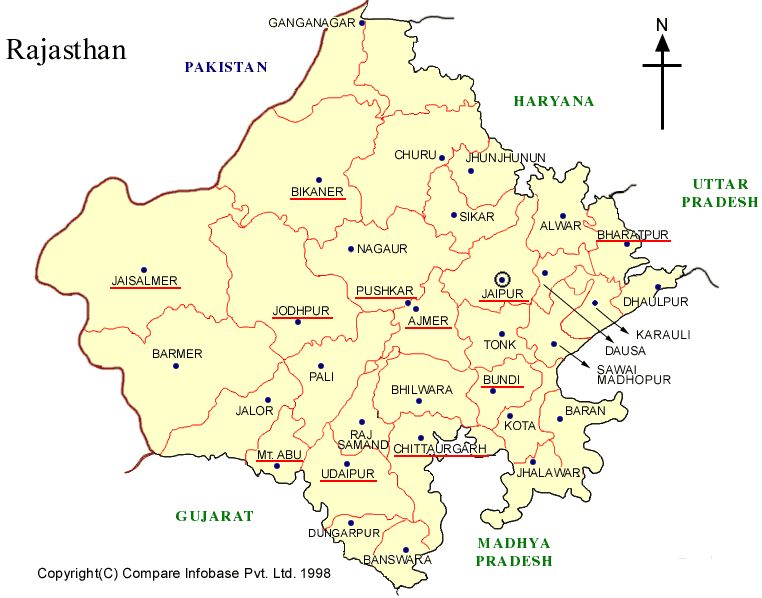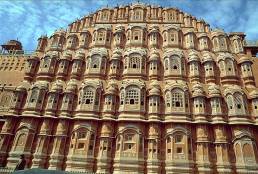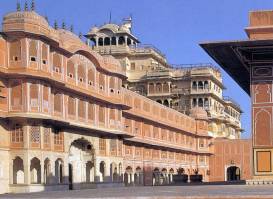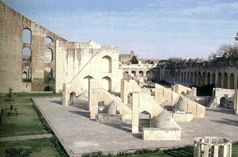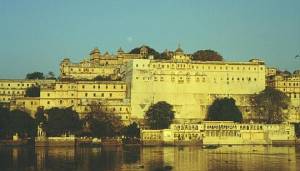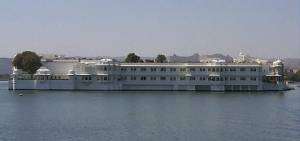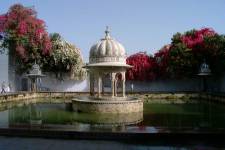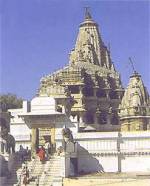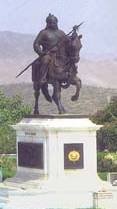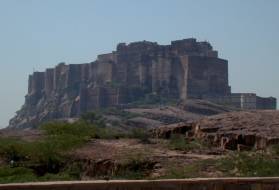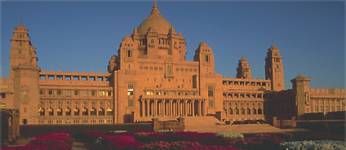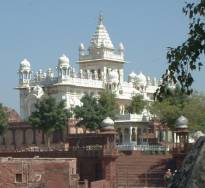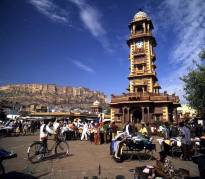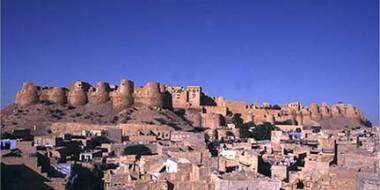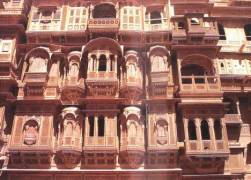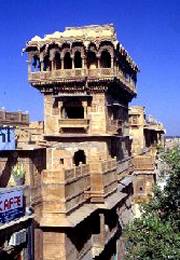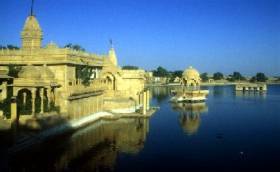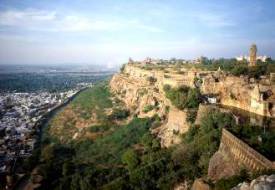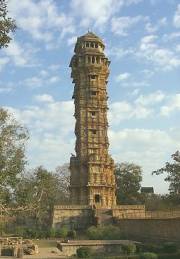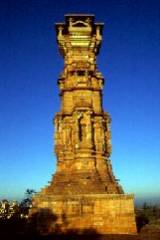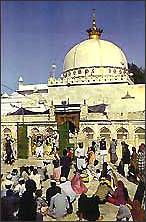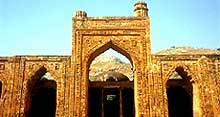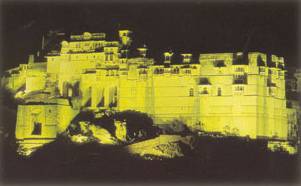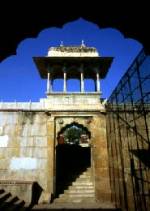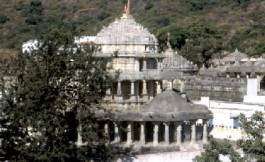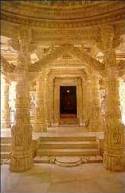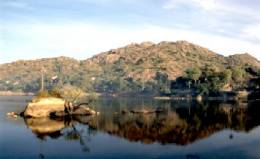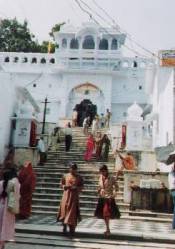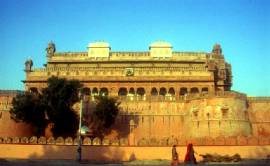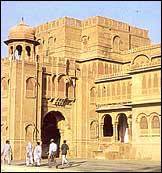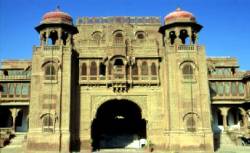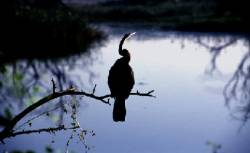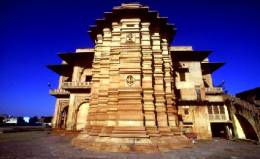Rajasthan is a state of western India. Its area is 342 239 km2 and its capital is Jaipur. More than 50 million people live in Rajasthan and the majority of the languages spoken are Hindi and Rajasthani.
Rajasthan is one of the states that attracts the most tourists because of the beauty of its cities and citadels witness to a rich historical and cultural past. The big cities are located in the eastern part of the state because much of the west is occupied by the Thar desert.
History
Rajasthan means "country of the Lords". For centuries the region was controlled and built by Rajputs who were warriors clans. Unable to unite with the Muslims, they gradually became the vassals of the Mughals and then the British. Most of the Rajput states were then ruled by idle Maharajas. During India's independence, Rajasthan was one of the least developed regions.
Map of the province of Rajasthan
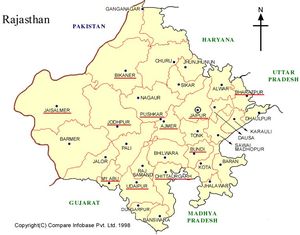
Map Rajasthan
Jaipur
Jaipur is the capital of the state of Rajasthan. It has nearly 2 million inhabitants. It is nicknamed "the pink city" because of the tint of the buildings of the old city. The city was founded by the maharaja Jai Singh II in the eighteenth century. He designed the city and the ramparts according to the principles enacted in the Hindu treatise on architecture, Shilpa Shastra. The whole city was painted in pink by the maharaja Ram Singh II in 1876 on the occasion of the visit of the Prince of Wales, the future Edward VII.
The old town is home to the main tourist attractions. It is surrounded by crenellated ramparts pierced with doors whose main ones are Chandpol, Sanganeri and Ajmeri. The avenues divide the old town into perfect rectangles. Several large bazaars enliven the city.
The Hawa Mahal
Hawal Mahal means "palace of the winds". It was built by the maharaja Sawai ai Singh II. It is in fact only a façade. It was intended to allow the women of the harem to look in the street without being seen. This facade has five floors pierced with magnificent semi-octagonal windows carefully perforated. It is a model of Rajput architecture. The access to the top of the building is allowed is allows to have a nice view on the Old City.
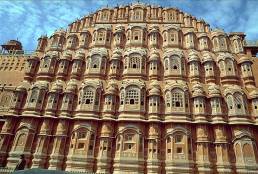
The Hawa Mahal
The palace of the city
Built in the heart of the Old City, the Palais de la Cité is composed of buildings between which were built courtyards and gardens. Not all buildings were erected at the same time. The Chandra Mahal occupies the central part. The ground floor houses a museum. Inside the palace several rooms are worth visiting including the Diwan-i-Am and its ancient manuscripts in Sanskrit and Persian, and the Diwan-i-Khas and its marble gallery.
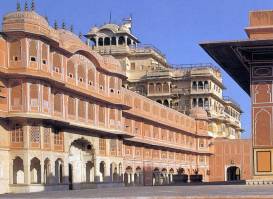
The palace of the city
The Jantar Mantar
It is the largest of the astronomical observatories built by Sawai Jai Singh II in the early 18th century. The other four can be found at Delhi , Ujjain, Mathura and Varanasi.
The constructions seem to be heterogeneous but they all have a precise astronomical function. The most spectacular is the gigantic sundial. It rises to 44m. The projected shadow moves 4m per hour and the reading on the dial is incredibly accurate.
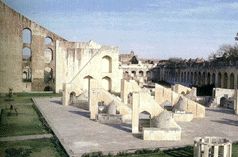
The Jantar Mantar
The fort of Nahargarh
The fort of Nahargarh, or fort of the tiger, built in 1734, overlooks the city. Most of the original buildings have fallen into ruin, but those later added in the 19th century have been properly preserved.
Les jardins de Sisodia Rani Ka Bagh
Ce jardin fut construit dans une gorge à 6km de Jaipur par Sawai ai Singh II pour son épouse Sisodia. Le jardin est décoré de fontaines, de ruisseaux et de petits pavillons sur lesquels ont été peintes des fresques.
Udaipur
The city of Udaipur was founded by Maharana Udai Singh in 1568 after the third sack of Chittorgarh by the armies of the Mughal emperor Akbar. Udaipur thus became the new capital of the Mewar. Pratap succeeded Udai Singh and resisted the Mughals without ever compromising. The Mewar was one of the few Rajput states to have never been under Mughal suzerainty. Shah Jahan even found refuge there when he revolted against his father Jahangir.
In the eighteenth century the princely state experienced dissensions and had to face the incursions of marathons. He signed a treaty of protection with the British and thus lost part of his autonomy. In 1947 it was definitively absorbed by the Indian republic.
The city palace
It is the largest palace of the Rajasthan. Its construction was initiated by the founder of the city and it was gradually enlarged while maintaining a remarkable architectural uniformity. The entrance is by Bari Pol (1600) and Tripolia (1725) with its eight sculpted arches. Between these two doors, it was a tradition that the maharana should be weighed. His weight in gold was then distributed to the poor.
Then you come to a series of courtyards, balconies, corridors, hanging gardens, and so on. You can visit several pavilions, such as Chini Chitrashala and its Chinese and Dutch ceramics, Mor Chowk and its peacock mosaics, Bhim Vilas and its murals, etc. A superb ice gallery overlooks the Durbar Hall built in 1909.
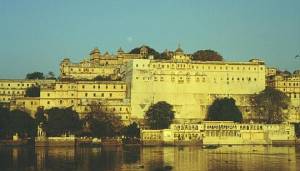
The city palace
The palace of the lake
As its name indicates this palace was built on Jagmandir Island located on Lake Pichola. Its construction was initiated by Karan Singh and continued by Jagat Singh in the seventeenth century. It was for a long time the summer residence of the Maharanas. It is said that the Mughal emperor Shah Jahan, during his stay in Udaipur, was inspired by parts of this palace for the construction of the Taj Mahal.
Today the palace houses a luxury hotel with incomparable charm.
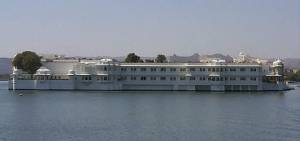
The palace of the lake
The Saheliyon Ki Bari
It is a pleasure garden nicknamed "Garden of the Bridesmaids" because the women of the royal family came to walk there. It has several beautiful fountains, kiosks and elephants in marble. Its calm and its atmosphere make it a place of walks appreciated.
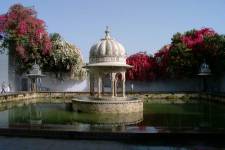
The Saheliyon Ki Bari
The temple of Jagdish
Built between 1628 and 1653 by the maharana Jagat Singh, the temple is dedicated to Jagannath (Vishnu), Lord of the Universe. The entrance is flanked by two large statues of elephants. The main sanctuary houses a black statue depicting Vishnu and an effigy of Garuda guarding the entrance. The pyramidal tower measures 26m high and is decorated with friezes. The temple has four shrines dedicated to Ganesh, Shiva, the sun god and the goddess Shakti. On the porch, a Sanskrit inscription dated 1651 tells the story of the reign of Jagat Singh.
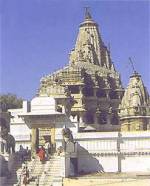
The temple of Jagdish
The Fateh Sagar
This lake surrounded by hills was built by Jai Singh in 1678 to serve as a reservoir. He built a dam to increase its volume. The largest of the three emerging islands has been converted into a park (Nehru Park) and is a popular walkway.
The memorial Pratap
Erected at the top of the hill of Modi Magri, this bronze equestrian statue celebrates the memory of Maharana Pratap, which resisted the Mughal invasion. She represents the hero Rajputs on her favorite horse, Chetak
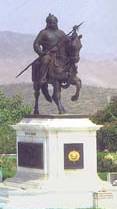
The memorial Pratap
Jodhpur
Nicknamed the "Blue City" because of the painted facades of the houses of the old city, Jodhpur was founded in 1459 by Rao Jodha at the gates of the Thar Desert. The city was then on the Silk Road and therefore welcomed a large number of travelers. The old town is surrounded by a wall of 10km long and pierced by seven gates.
Jodhpur still occupies a key geostrategic position due to the proximity of Pakistan.
Meherangarh Fort
This majestic and impressive citadel dominates the city from the top of a hill 120m above sea level. Some enclosure walls have a thickness of more than 5m and a height of more than 20m.
Inside are several palaces known for their sculptures and their successions of courses. The Moti Mahal with its sculpted façade houses the royal throne of Jodhpur, the Sringar Chowki. The Villa Umaid contains Rajput miniatures and the villa Ajit contains instruments of music and royal costumes. The coat of arms of Jodhpur is kept in the Phool Mahal.
Beside one of the enclosing gates, the Lohapol or Iron Gate, are the imprint of the fifteen hands of widows of the maharaja Man Singh who died in 1843 and immolated himself on his stake.
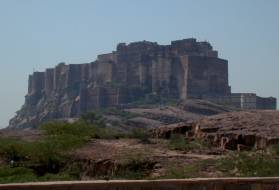
Meherangarh Fort
The palace of Umaid Bhawan
This palace of marble and sandstone was built between 1929 and 1944 by the maharaja Umaid Singh. His descendants still live in a part of the palace but most of the building has been converted into a luxury hotel. There is also a museum where you can see the maharaja's property.
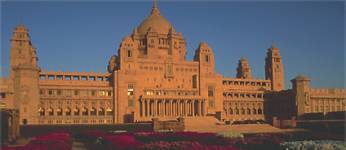
The palace of Umaid Bhawan
The Jaswant Thada
This white marble cenotaph was erected in 1899 in memory of the maharaja Jaswant Singh. Portraits of some Jodhpur leaders are visible inside.
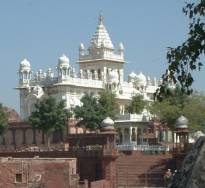
The Jaswant Thada
The Clock Tower and the Sardar Market
The clock tower is a well-known gathering place in the old town of Jodhpur. This is the typical neighborhood of Jodhpur. At the foot of the tower stretches the market of Sardar.
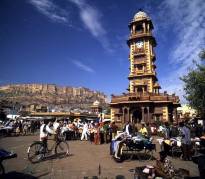
The Clock Tower and the Sardar Market
Jaisalmer
Jaisalmer was above all a military outpost. The city was founded around the fort built in the middle of the Thar desert in 1156 by Rawal Jaisal. Its geographical location enabled the city to control the main trade routes to Arabia and North Africa. There was a growing prosperity which attracted the wealthy merchants. They built sumptuous dwellings. The development of maritime trade and competition from Mumbai led to its decline.
The city is today one of the wonders of Rajasthan known for its magnificent sunsets, small streets and craftsmen.
The fort
This citadel was built in 1156 at the top of Trikuta hill. Its surrounding wall consists of 99 bastions (added in the 17th century) and it surrounds the old town. You enter through large doors opening onto a large courtyard where the maharaja palace stands. The interior of the citadel is made up of narrow alleys where countless shops and hotels can be found. There is a unique atmosphere.
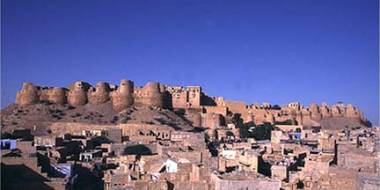
The fort
The Havelis
This term refers to the sandstone mansions once built by the wealthy inhabitants of Jaisalmer. They are located outside the Fort.
Patwon-ki-Haveli: It is one of the most beautiful houses of its kind. Located in a very small street, it has been divided into six apartments. You can still see frescoes inside.
Salim-Singh-ki-Haveli: It was built around 1815 by the prime minister of Jaisalmer, Salim Singh. He built eight levels, 38 different balconies and a vaulted roof adorned with sculptures.
Nathmal-ki-Haveli: It was built by Prime Minister Diwan Mohata Nathmal in 1885. He commissioned it from two brothers who built one half each. The right and left wings are therefore different. The entrance is guarded by two statues of elephants. The interior is decorated with magnificent miniatures.
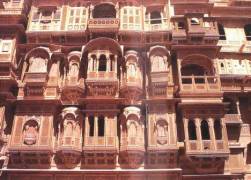
The Havelis
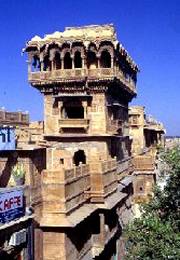
The Havelis
Le Gadisagar
This artificial reservoir was built to supply the city with water. It served until 1965. It is surrounded by small sanctuaries and is accessed under an arch built by Teelon, a courtesan. The king tried to destroy it because a sovereign could not pass under a door built by a woman. But Teelon had a statue of Krishna placed on top of it to prevent its destruction.
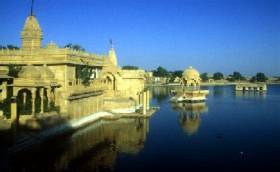
Le Gadisagar
Les temples Jaïnas
This group of temples, located inside the Fort, were built in the 12th and 15th centuries. Beautifully carved, they are dedicated to Rikhabdevji and Sambhavnathji. Inside is a library with old manuscripts.
Chittorgarh
Chittorgarh (or Chittor) was founded in the eighth century by Bappa Rawal. The city is famous by the three seats that its inhabitants faced and by the particularly bloody way they ended. The inhabitants of Chittorgarh, faced with defeat, declared the jauhar. The men fought until death in a saffron dress while the women immolated themselves with their children.
The first siege took place in 1303 on the initiative of Alauddin Khilji who had fallen in love with Padmini and wanted to marry her. Alauddin took Chittor but Padmini and 30,000 women immolated themselves by fire. The second siege took place in 1535 after the Shah of Gujarat declared war on Chittor. Another 32,000 men died on the battlefield and 13,000 women sacrificed. The last seat was the work of the Mughal Emperor Akbar in 1568. 8000 Rajputs died in the final assault and the women and children were all dead when Akbar entered the fort. Maharaja Udai Singh II had fled to rebuild his capital in Udaipur.
The Mughal Jahangir returned Chittor to the Rajputs in 1616.
The fort
This citadel was built on a rocky plateau 170m high. The entry into the fort is through seven gates which were designed for a defensive purpose. The memory of two heroes of Chittorgarh, who died during the siege of 1568, is celebrated. Their cenotaphs were built by the Rajputs. The first one rises near the gate Bhairon Pol where Jaimal died, the second near the main gate Ram Pol where Patta died. Akbar himself carved two statues to the glory of his two adversaries. The entrance to the east side is via the Suraj Pol (the gate of the sun).
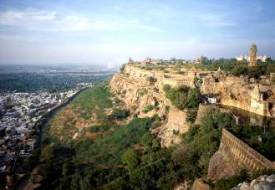
The fort
The Towers of Glory
These two towers are the most imposing monuments of Chittorgarh.
The Victory Tower (Jaya Stambha) was erected by Rana Kumbha in 1458 after its victory over the armies of the Malwa and the Gujarat. It measures 37m high and has eight floors with balcony. You can see beautiful sculptures of Hindu deities and scenes of the Mahabharata and the Ramayana.
The Tower of Fame (Kirti Stambha) was dedicated to the first saint Jaina, Adinath. It is 25m high and has six floors adorned with statues of the Saints Jainas. There are Jain inscriptions dating from 896 on the walls.
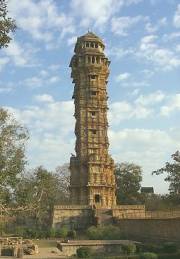
The Towers of Glory
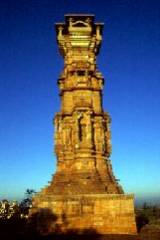
The Towers of Glory
The palais of Rana Kumbha
Located in the fort the Rana Kumbha palace is now in ruins. There are stables and a temple dedicated to Shiva. It is believed that the jauhar of 1303 in which Padmini died took place in the cellars of the palace.
The palace of Padmani
Built near a pond, this palace was that of Padmini. According to legend it is here that Alauddin Khilji saw the reflection of Padmini in a mirror and decided to possess it by destroying Chittorgarh. The bronze doors of the main pavilion were taken by Akbar to Agra.
Les tours de la gloire
Built in the 8th century for the cult of the god of the Sun, it was later dedicated to the goddess Kali in the 14th century.
Ajmer
Ajmer was founded in the 11th century by the Chauhan dynasty before being taken by the Mughals of the Delhi Sultanate in 1193. It remained under their control until 1326 after which it was disputed by the Moghols, Rathor and Rana of Marwar and the sultans of Gujarat. Peace was re-established in 1556 with the arrival of the Mughal emperor Akbar. In the eighteenth century the Marathas contested Mughal supremacy and seized Ajmer in 1770. In 1818 the British took full control of it.
Ajmer is one of the great pilgrimage centers of Sufi Muslims.
The Dargah
This building houses the tomb of a Sufi saint, Khwaja Muin-ud-din Chishti, who came from Persia in 1192. The anniversary of his death is celebrated during the month of Urs and attracts many pilgrims.
The entrance to the Dargah is through the Buland Darwaza and leads to an inner courtyard where there are two enormous pots to collect the offerings. The tomb is surrounded by a silver platform and is surmounted by a marble dome.
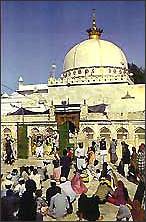
The Dargah
The Adhai-Din-Ka-Jhonpra
This mosque is now in ruins but remains one of the finest examples of Indo-Muslim architecture. The building was originally a Sanskrit school but was converted into a mosque by Mohammed of Ghur in 1193. The pillars of the mosque are all different and the arcaded walls are covered with inscriptions from the Koran.
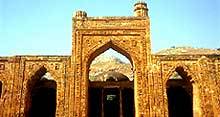
The Adhai-Din-Ka-Jhonpra
The royal palace of Akbar
The ancient palace of the Mughal Emperor Akbar, built in 1570, has been converted into a museum. There is a collection of Mughal and Rajput weapons and a very fine collection of sculptures.
Bundi
Bundi was until 1947 the capital of a princely state Rajput. In 1342 Rao Dewa founded the kingdom of Haravati by making Bundi his capital. At that time, Kota, a neighboring town, was under the control of Bundi. It was in 1624, under the pressure of the Mughal emperor Jehangir, that the two cities became two independent fiefs. The modern city has retained a medieval atmosphere.
The fort of Taragarh
Also known as Fort de l'Étoile, this building was built on the top of a hill in 1354. It is penetrated by a large door surmounted by elephants. The fort is dominated by a large tower, the Bhim Burj, built in the 16th century to house an enormous cannon, the Garbh Gunjam. The walls of the fort have in some places more than 3m thick. The fort was abandoned and there is not much to see inside.
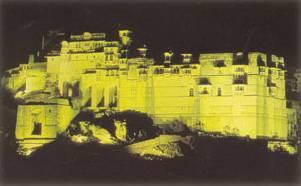
The Dargah
The palace
This building is a very good example of Rajput architecture. Unfortunately, due to a family dispute between the maharaja and his sister, only two parties, the Chitra Mahal and the Ummed Mahal, are open to the public. To visit the rest of the palace, which contains superb mural paintings, you need special permission from the maharaja.
The Ranigi-Ki-Baori
The baoris are subterranean wells. The Raniji-ki-Baori is the most important and the most beautiful. It was built in 1699 by Rani Nathavati. It is 46m deep. One enters it by a vaulted door flanked by delicately carved pillars.
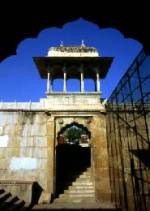
The Ranigi-Ki-Baori
The Chaurasi-Khambon-Ki-Chhatri
Chaurasi-Khambon-ki-Chhatri means "cenotaph to the 84 pillars." It was erected in memory of Deva, son of the nurse of Rao Raja Anirudh Singh in 1683. At its center is a lingam. The edifice is therefore both a temple and a cenotaph. The ceiling is covered with paintings and walls of delicate sculptures.
Mount Abu
The region of Sirohi was colonized very early in history as traces of human activities dating back to -1000 years were found. Various dynasties followed (Rashtrakuta, Paramara, Chalukya). Mount Abu's location on a hill made it relatively easy to defend. It was not until 1573 that the Sirohi entered directly into conflict with the Mughals. The region was annexed in 1580 by the Mughal province of Ajmer. The British added a new page to the history of Mount Abu. In 1822, Colonel James Tod "discovers" Mount Abu. The Sirohi region was one of the last Rajput provinces to sign a treaty of defensive alliance and cooperation with the English on September 11, 1823. In 1917 the ruler of Sirohi agreed to rent Mount Abu to the English for 27,000 rupees a year . In July 1947 the city was retroceded to Sirohi before being attached to Bombay in 1950. November 1, 1956 Mount Abu is definitely integrated into Rajasthan.
Mount Abu is today, with its 1200m altitude, the only climatic resort of Rajasthan. Activities are grouped around Lake Nakki.
The Jain temples of Dilwara
These temples are undoubtedly the most beautiful jainas sanctuaries of India. The sculptures of marble are of a fineness rarely equaled. Two temples stand out: the Vimala Vasahi and the Luna Vasahi.
- The Vimala Vasahi was built by Vimala Shah in 1031 and dedicated to the first holy jaina, Adinatha. Its rather simple facade conceals an interior of an incredible beauty. The entrance leads to a pavilion with a smosan (symbolic representation of the sacred mountain of the jainas) surrounded by statues of elephants. The visitors then enter a courtyard containing the sanctuary in the center of which is a statue of Adinatha with crossed legs. The dome of the sanctuary is beautifully carved with animal representations. 52 cells, in which there is a statue, surround the courtyard.
- The Luna Vasahi was erected in 1230 by Tejpala and Vasupala and dedicated to the 22nd holy jaina, Neminath. The marble decorations of the temple are very elaborate. In places the marble is so fine that it is almost translucent. The dome is also the masterpiece of the temple, especially the lotus flower in the center.
The other two temples are the temple of Chaumukha and the temple of Sri Risha Deoji.
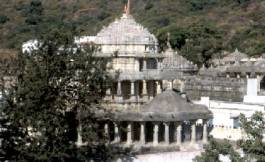
The Jain temples of Dilwara
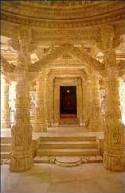
The Jain temples of Dilwara
The lake Nakki
It owes its name to the legend that the gods dug the lake with their nails (nakh). The Hindus consider the waters of the lake as sacred and bathe there to purify themselves. Located in the heart of the city, it offers beautiful walks. The temple of Raghunath (14th century) is on the banks.
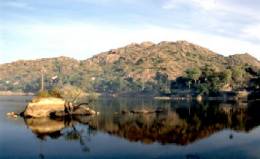
The lake Nakki
The temple of Gaumukh
The place owes its name to a natural spring that springs from the mouth of a cow sculpted in marble. The temple was carved into a rock in a beautiful natural setting. According to legend it is here that the sage Vasishta regenerated the human race by giving birth to the four Rajput clans. Not far away is a statue of Nandi, the mount of Shiva, saved by the snake Arbuda.
Pushkar
Located at the gateway to the desert, Pushkar is a holy city of Hinduism. Approximately 400 temples and sanctuaries stand around the sacred lake. According to the religious texts, Brahma made a ritual sacrifice (yajna) on his shores.
Pushkar is now world famous for its camel fair in October or November.
The temple of Brahma
It is the only great temple in India dedicated to Brahma. Built in the 14th century it is accessed by a marble staircase. The entrance to the temple is flanked by geese, sacred Brahma mounts. A silver turtle faces the sanctuary. Around her hundreds of silver coins have been embedded in the marble, they bear the names of donors. The walls are decorated with peacocks, Saraswati, Brahma's wife. A small adjoining temple is dedicated Shiva.
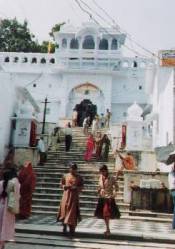
The temple of Brahma
The Ghats
The lake is surrounded by stairs called ghats used by Hindus to immerse themselves in the lake for the purifying bath. According to legend, Vishnu would have appeared on the Varah Ghat in the form of a wild boar and Brahma would have performed a sacrifice on the Brahma Ghat. The ashes of the Mahatma Gandhi were immersed at the bottom of the Gau Ghat, which has since become the Gandhi Ghat. If you go to the ghats, do not forget that this is a sacred place. Lose yourself and avoid taking the pilgrims.
In the evening, the faithful put in the water oil lamps placed on trays. This gives a spectacular view of the lake at dusk.
The camel fair
The date of the fair is determined by the full moon of the month of Kartik. It attracts tens of thousands of people, merchants, tourists, reporters, pilgrims ... and thousands of camels and cattle. This is the most popular fair of Rajasthan . Various festivities enliven the days (camel races, theater, music, etc.) The atmosphere is unique and leaves an indelible memory to visitors.
Bikaner
The city of Bikaner was founded in 1488 by Bika, son of Rao Jodha the founder of Jodhpur. Like most Rajput sovereigns, those of Bikaner had to face the Lodis and the Mughals. In 1537 the latter suffered a severe defeat at the foot of the ramparts of Bikaner. But the city was eventually taken by the Jodhpur raja and Bikaner allied himself with the then-Delhi ruler, Sher Shah Suri. His armies marched on Jodhpur and Sher Shah reinstated Rao Kalyanmal on the throne of Bikaner in 1546.
At the end of the sixteenth century, and with the support of the Mughals, Bikaner took control of Jodhpur. The Rajput states retained their independence from the Mughals, but when the power of the latter began to decline, they had to cope with the rise of the marathas and then the British. The Indian Company and the Maharaja of Bikaner signed a treaty of good understanding in 1818. Maharaja Sardar Singh was the only ruler of all Rajasthan to have fought alongside the English. Maharaja Ganga Singh was one of the signatories of the Treaty of Versailles, which ended the First World War.
Bikaner, like all the Rajput states, was incorporated into the Indian Union in 1949. The title of maharaja of Bikaner is always transmitted. Bikaner is known for its camel farms considered one of the best in the world. The Bikaner camel fair is internationally renowned.
The junagarh
This fort was built between 1589 and 1594 by Raja Rai Singh. It has a rampart of 986 m long fortified by 37 bastions. Unlike most Rajput fortresses the Junagarh was not built on a hill but in the plain.
It is embellished with Rajput paintings, mirrors and carved marble panels distributed among the palaces and pavilions of the fort. The lines of windows and balconies give a harmonious character to the austere architecture of the citadel.
The fort has two entrances: the Karan Pol to the east and the Chand Pol to the west. Near the Karan Pol is the place where widows practiced sati (ritual immolation on the pyre of their late husband). There are other doors including Daulat Pol, Fateh Pol and Suraj Pol (Gate of the Sun) which used to be the main entrance. Statues of Jaimal and Patta, the heroes of Chittorgarh, on the back of elephants stand near the latter.
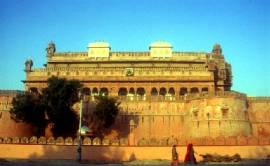
The Junagarh
The Havelis
The havelis are the houses built by wealthy merchants in the old town in the 17th century. They are remarkable for their architectural structure and the finesse of their sculptures. The interior decoration, with its gigantic chandeliers, the wooden panels of the walls, the murals, is no less impressive. The most beautiful havelis are the Rampuria Haveli and the Kothari Haveli.

The Havelis
The palace of Lalgarh
It was built by the English architect Samuel S. Jacob for the maharaja Ganga Singh in the 1890s. The construction stones were extracted from the quarries of the village of Dulmera after a long search because the young sovereign wanted stones of a similar color to those used in Jodhpur.
The palace, with its carved panels, pavilions, various ornaments, balconies, is a feast for the eyes. The billiard room is decorated with hunting trophies. On the first floor is a museum where you can see an extraordinary collection of objects that belonged to the maharaja.
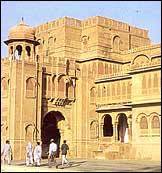
The palace of Lalgarh
The Lakshmi Niwas
This palace is located near the Lalgarh Palace. Reconverted into a luxury hotel, it is remarkable for its beautiful architecture and its stone sculptures.
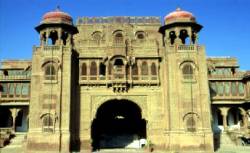
The Lakshmi Niwas
Bharatpur
The town of Bharatpur was, in the 17th and 18th century, the bastion of the Jats. Fiercely attached to their independence, they fought the Mughals and, to a lesser extent, the Rajputs. Their art of war allowed them to go as far as Delhi and control Agra before being driven out by the marathons.
Even the British broke their teeth on the jats defenses and the attack of Bharatpur in 1805 was a bitter failure for the English. The latter signed a treaty with the jats in 1818. But in 1825 Lord Combermere attacked the city and successfully supported a siege for a month. At the end of this, a new treaty was signed giving effective power to the English, the sovereign Jat having only then an honorary role.
Today Bharatpur is best known for its ornithological reserve.
Keoladeo Ghana National Park
Located south of Bharatpur, the place was once the hunting reserve of the maharaja of Bharatpur. Inside the park is a small temple near which there is a pillar on which one can read that more than 5000 ducks were slaughtered in one day! The park is now one of the most beautiful ornithological reserves in the world. There are more than 350 species of birds. Many migratory species come from the north to nest. It is said that 7 of the 17 known stork species can be seen in the park. It would take too long to describe the beauties and exceptional character of some birds but the site is a marvel for the eyes and ears.
The best way to visit the park is by bike, which can be rented at the entrance, and the boat. You can also go for a walk in a tonga pulled by horses or in a rickshaw. Many qualified guides offer their service and will help you to distinguish the species.
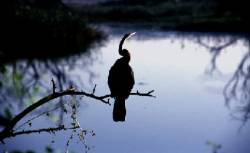
Keoladeo Ghana National Park
The Lohagarh
Lohagarh means "strong iron". Built on an artificial island by the founder of the city, Suraj Mal, in the eighteenth century it is surrounded by deep moats that have made it an impregnable place. The outer walls of the fort were covered with mud so that the cannonballs sank into it before being recovered by the defenders. The British destroyed these walls and only the interior walls survive today.
The main entrance is through the Ashtadhatu gate. It was first built for the fort of Chittorgarh. From there she was taken to Delhi by Sultan Alauddin Khilji. The Jats, during their raid on Delhi in 1764, brought her back to Bharatpur. Inside the temple are three palaces and two towers, the Jawahar Burj erected in 1765 to celebrate the victory over Delhi, and the Fateh Burj built after the victory over the English in 1805.

The Lohagarh
The temple of Ganga
The construction of this two-storey temple began in 1845 but was not completed until 1937. It is dedicated to Ganga, the goddess of the Ganges. Fine carved panels represent flowers and deities, and the ground is in checkerboard. The ceilings are also decorated.
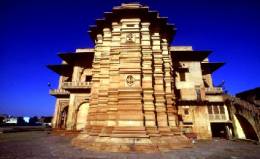
The temple of Ganga
See also:





